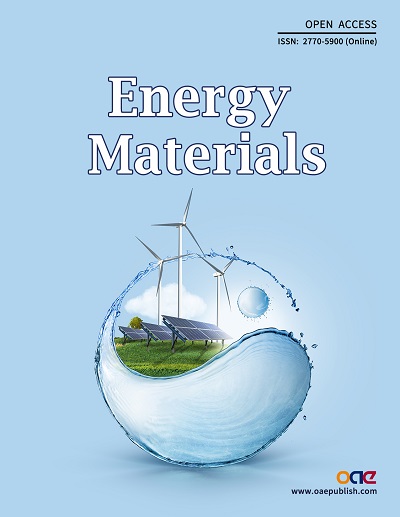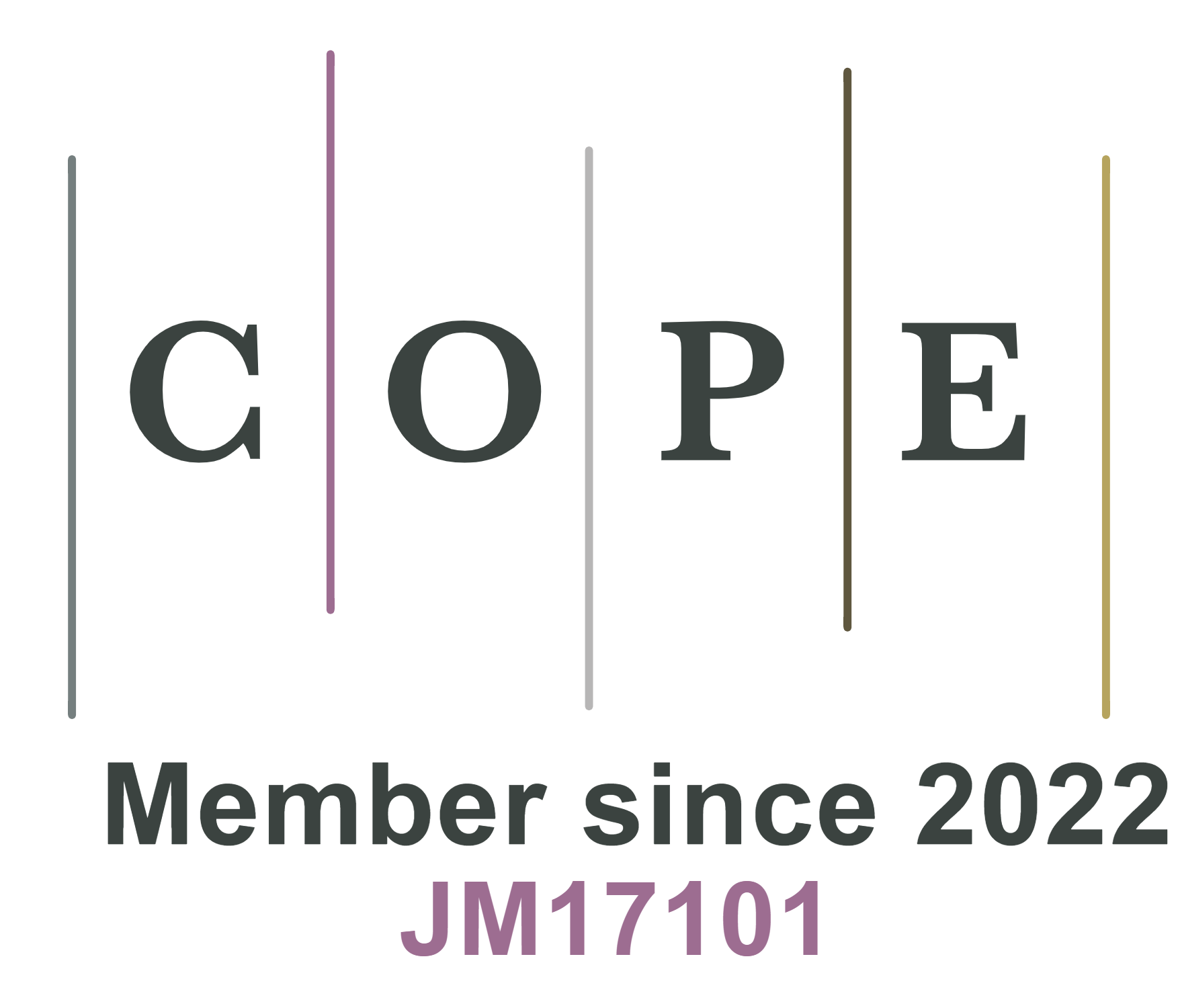REFERENCES
1. Perera ATD, Nik VM, Chen D, Scartezzini J, Hong T. Quantifying the impacts of climate change and extreme climate events on energy systems. Nat Energy 2020;5:150-9.
2. Capellán-pérez I, Mediavilla M, de Castro C, Carpintero Ó, Miguel LJ. Fossil fuel depletion and socio-economic scenarios: an integrated approach. Energy 2014;77:641-66.
3. Bashir T, Ismail SA, Song Y, et al. A review of the energy storage aspects of chemical elements for lithium-ion based batteries. Energy Mater 2021;1:100019.
4. Xiao Y, Xu R, Xu L, Ding J, Huang J. Recent advances on anion-derived sei for fast-charging and stable lithium batteries. Energy Mater 2021;1:100013.
5. Alias N, Mohamad AA. Advances of aqueous rechargeable lithium-ion battery: A review. J Power Sources 2015;274:237-51.
6. Li C, Zhang X, Zhu Y, et al. Modulating the lithiophilicity at electrode/electrolyte interface for high-energy Li-metal batteries. Energy Mater 2021;1:100017.
7. Zhang L, Chen Y. Electrolyte solvation structure as a stabilization mechanism for electrodes. Energy Mater 2021;1:100004.
8. Ruan J, Sun H, Song Y, et al. Constructing 1D/2D interwoven carbonous matrix to enable high-efficiency sulfur immobilization in Li-S battery. Energy Mater 2021;1:100018.
9. Chen X, Zhao J, Li G, Zhang D, Li H. Recent advances in photocatalytic renewable energy production. Energy Mater 2022;2:200001.
10. Yahya N, Aziz F, Jamaludin N, et al. A review of integrated photocatalyst adsorbents for wastewater treatment. J Environ Chem Eng 2018;6:7411-25.
11. Wang X, Ou P, Ozden A, et al. Efficient electrosynthesis of n-propanol from carbon monoxide using a Ag-Ru-Cu catalyst. Nat Energy 2022;7:170-6.
12. Vangari M, Pryor T, Jiang L. Supercapacitors: review of materials and fabrication methods. J Energy Eng 2013;139:72-9.
13. He C, Cheng J, Liu Y, Zhang X, Wang B. Thin-walled hollow fibers for flexible high energy density fiber-shaped supercapacitors. Energy Mater 2021;1:100010.
14. Zhang L, Hu X, Wang Z, Sun F, Dorrell DG. A review of supercapacitor modeling, estimation, and applications: a control/management perspective. Renew Sust Energ Rev 2018;81:1868-78.
15. Yang M, Wei W, Zhou X, Wang Z, Duan C. Non-fused ring acceptors for organic solar cells. Energy Mater 2021;1:100008.
16. Zhang C, Liang S, Liu W, et al. Ti1-graphene single-atom material for improved energy level alignment in perovskite solar cells. Nat Energy 2021;6:1154-63.
17. Dodds PE, Staffell I, Hawkes AD, et al. Hydrogen and fuel cell technologies for heating: a review. Int J Hydrog Energ 2015;40:2065-83.
18. Lu Y, Zhu B, Shi J, Yun S. Advanced low-temperature solid oxide fuel cells based on a built-in electric field. Energy Mater 2021;1:100007.
19. Zhu B, Mi Y, Xia C, et al. Nano-scale view into solid oxide fuel cell and semiconductor membrane fuel cell: material and technology. Energy Mater 2021;1:100002.
20. Zhang X, Liu G, Zhou K, et al. Enhancing cycle life of nickel-rich LiNi0.9Co0.05Mn0.05O2 via a highly fluorinated electrolyte additive - pentafluoropyridine. Energy Mater 2021;1:100005.
21. Wang Y, Xu H, Zhong J, et al. Hierarchical Ni/Co-based oxynitride nanoarrays with superior lithiophilicity for high-performance lithium metal anode. Energy Mater 2021;1:100012.
22. Yang C, Gao N, Wang X, et al. Phosphate boosting stable efficient seawater splitting on porous NiFe (oxy)hydroxide@NiMoO4 Core-Shell micropillar electrode. Energy Mater 2021;1:100015.
23. Guan Z, Wu Y, Wang P, et al. Perovskite photocatalyst CsPbBr3-xIx with a bandgap funnel structure for H2 evolution under visible light. Appl Catal B 2019;245:522-7.
24. Cui P, Qu S, Zhang Q, et al. Perovskite homojunction solar cells: opportunities and challenges. Energy Mater 2021;1:100014.
25. Mei A, Li X, Liu L, et al. A hole-conductor-free, fully printable mesoscopic perovskite solar cell with high stability. Science 2014;345:295-8.
26. Kim HS, Jang IH, Ahn N, et al. Control of I-V hysteresis in CH3NH3PbI3 perovskite solar cell. J Phys Chem Lett 2015;6:4633-9.
27. Lu J, Li Y. Perovskite-type Li-ion solid electrolytes: a review. J Mater Sci: Mater Electron 2021;32:9736-54.
28. Choudhary K, Bercx M, Jiang J, Pachter R, Lamoen D, Tavazza F. Accelerated discovery of efficient solar-cell materials using quantum and machine-learning methods. Chem Mater 2019;31:5900-8.
30. Wang Q, Phung N, Di Girolamo D, Vivo P, Abate A. Enhancement in lifespan of halide perovskite solar cells. Energy Environ Sci 2019;12:865-86.
31. Srivastava M, Howard JM, Gong T, Rebello Sousa Dias M, Leite MS. Machine learning roadmap for perovskite photovoltaics. J Phys Chem Lett 2021;12:7866-77.
32. Pilania G, Mannodi-Kanakkithodi A, Uberuaga BP, Ramprasad R, Gubernatis JE, Lookman T. Machine learning bandgaps of double perovskites. Sci Rep 2016;6:19375.
33. Im J, Lee S, Ko T, Kim HW, Hyon Y, Chang H. Identifying Pb-free perovskites for solar cells by machine learning. npj Comput Mater 2019:5.
34. Tao Q, Xu P, Li M, Lu W. Machine learning for perovskite materials design and discovery. npj Comput Mater 2021:7.
35. Jain A, Ong SP, Hautier G, et al. Commentary: the materials project: a materials genome approach to accelerating materials innovation. APL Materials 2013;1:011002.
36. Saal JE, Kirklin S, Aykol M, Meredig B, Wolverton C. Materials design and discovery with high-throughput density functional theory: the open quantum materials database (OQMD). JOM 2013;65:1501-9.
37. Castelli IE, Landis DD, Thygesen KS, et al. New cubic perovskites for one- and two-photon water splitting using the computational materials repository. Energy Environ Sci 2012;5:9034.
38. Hellenbrandt M. The inorganic crystal structure database (ICSD) - present and future. Crystallography Reviews 2014;10:17-22.
39. Curtarolo S, Setyawan W, Hart GL, et al. AFLOW: an automatic framework for high-throughput materials discovery. Comput Mater Sci 2012;58:218-26.
40. Groom CR, Bruno IJ, Lightfoot MP, Ward SC. The cambridge structural database. Acta Crystallogr B Struct Sci Cryst Eng Mater 2016;72:171-9.
41. Gražulis S, Daškevič A, Merkys A, et al. Crystallography Open Database (COD): an open-access collection of crystal structures and platform for world-wide collaboration. Nucleic Acids Res 2012;40:D420-7.
42. Jain A, Montoya J, Dwaraknath S, et al. The materials project: Accelerating materials design through theory-driven data and tools. In: Andreoni W, Yip S, editors. Handbook of Materials Modeling: Methods: Theory and Modeling. Springer; 2020. pp. 1751-84. .
43. Oviedo F, Ren Z, Sun S, et al. Fast and interpretable classification of small X-ray diffraction datasets using data augmentation and deep neural networks. npj Comput Mater 2019:5.
44. Xu Q, Li Z, Liu M, Yin WJ. Rationalizing perovskite data for machine learning and materials design. J Phys Chem Lett 2018;9:6948-54.
45. Zhai X, Chen M, Lu W. Accelerated search for perovskite materials with higher Curie temperature based on the machine learning methods. Comput Mater Sci 2018;151:41-8.
46. Xie T, Grossman JC. Crystal graph convolutional neural networks for an accurate and interpretable prediction of material properties. Phys Rev Lett 2018;120:145301.
47. Kirman J, Johnston A, Kuntz DA, et al. Machine-learning-accelerated perovskite crystallization. Matter 2020;2:938-47.
48. Saidi WA, Shadid W, Castelli IE. Machine-learning structural and electronic properties of metal halide perovskites using a hierarchical convolutional neural network. npj Comput Mater 2020:6.
49. Vicente N, Garcia-Belmonte G. Methylammonium lead bromide perovskite battery anodes reversibly host high li-ion concentrations. J Phys Chem Lett 2017;8:1371-4.
50. Liu M, Johnston MB, Snaith HJ. Efficient planar heterojunction perovskite solar cells by vapour deposition. Nature 2013;501:395-8.
51. He Q, Gu H, Zhang D, Fang G, Tian H. Theoretical analysis of effects of doping MAPbI into p-n homojunction on several types of perovskite solar cells. Optical Materials 2021;121:111491.
52. Odabaşı Ç, Yıldırım R. Performance analysis of perovskite solar cells in 2013-2018 using machine-learning tools. Nano Energy 2019;56:770-91.
53. Ye M, Hong X, Zhang F, Liu X. Recent advancements in perovskite solar cells: flexibility, stability and large scale. J Mater Chem A 2016;4:6755-71.
54. Sun S, Hartono NT, Ren ZD, et al. Accelerated development of perovskite-inspired materials via high-throughput synthesis and machine-learning diagnosis. Joule 2019;3:1437-51.
55. Li W, Jacobs R, Morgan D. Predicting the thermodynamic stability of perovskite oxides using machine learning models. Computational Materials Science 2018;150:454-63.
56. Jacobs R, Mayeshiba T, Booske J, Morgan D. Material discovery and design principles for stable, high activity perovskite cathodes for solid oxide fuel cells. Adv Energy Mater 2018;8:1702708.
57. Schmidt J, Shi J, Borlido P, Chen L, Botti S, Marques MAL. Predicting the thermodynamic stability of solids combining density functional theory and machine learning. Chem Mater 2017;29:5090-103.
58. Deng Q, Lin B. Automated machine learning structure-composition-property relationships of perovskite materials for energy conversion and storage. EM 2021; doi: 10.20517/energymater.2021.10.
59. Priya P, Aluru NR. Accelerated design and discovery of perovskites with high conductivity for energy applications through machine learning. npj Comput Mater 2021:7.
60. Shen Z, Bao Z, Cheng X, et al. Designing polymer nanocomposites with high energy density using machine learning. npj Comput Mater 2021:7.
61. Kim C, Pilania G, Ramprasad R. Machine learning assisted predictions of intrinsic dielectric breakdown strength of ABX3 perovskites. J Phys Chem C 2016;120:14575-80.
62. Xu P, Chang D, Lu T, Li L, Li M, Lu W. Search for ABO3 type ferroelectric perovskites with targeted multi-properties by machine learning strategies. J Chem Inf Model 2021; doi: 10.1021/acs.jcim.1c00566.
63. Li J, Pradhan B, Gaur S, Thomas J. Predictions and strategies learned from machine learning to develop high-performing perovskite solar cells. Adv Energy Mater 2019;9:1901891.
64. Gok EC, Yildirim MO, Haris MPU, et al. Predicting perovskite bandgap and solar cell performance with machine learning. Solar RRL 2022;6:2100927.
65. Jiang S, Wu C, Li F, et al. Machine learning (ML)-assisted optimization doping of KI in MAPbI3 solar cells. Rare Met 2021;40:1698-707.
66. Zhao Y, Zhang J, Xu Z, et al. Discovery of temperature-induced stability reversal in perovskites using high-throughput robotic learning. Nat Commun 2021;12:2191.
67. Xu X, Wang X. Perovskite nano-heterojunctions: synthesis, structures, properties, challenges, and prospects. Small Structures 2020;1:2000009.
68. Braham EJ, Cho J, Forlano KM, Watson DF, Arròyave R, Banerjee S. Machine learning-directed navigation of synthetic design space: a statistical learning approach to controlling the synthesis of perovskite halide nanoplatelets in the quantum-confined regime. Chem Mater 2019;31:3281-92.
69. Yang Z, Liu Y, Zhang Y, et al. Machine learning accelerates the discovery of light-absorbing materials for double perovskite solar cells. J Phys Chem C 2021;125:22483-92.
70. Sun S, Tiihonen A, Oviedo F, et al. A data fusion approach to optimize compositional stability of halide perovskites. Matter 2021;4:1305-22.
71. Ahmadi M, Ziatdinov M, Zhou Y, Lass EA, Kalinin SV. Machine learning for high-throughput experimental exploration of metal halide perovskites. Joule 2021;5:2797-822.
72. Häse F, Roch LM, Aspuru-guzik A. Next-generation experimentation with self-driving laboratories. Trends in Chemistry 2019;1:282-91.
73. Li Z, Najeeb MA, Alves L, et al. Robot-accelerated perovskite investigation and discovery. Chem Mater 2020;32:5650-63.
74. Chen S, Hou Y, Chen H, et al. Exploring the stability of novel wide bandgap perovskites by a robot based high throughput approach. Adv Energy Mater 2018;8:1701543.
75. Gu E, Tang X, Langner S, et al. Robot-based high-throughput screening of antisolvents for lead halide perovskites. Joule 2020;4:1806-22.
76. Higgins K, Valleti SM, Ziatdinov M, Kalinin SV, Ahmadi M. Chemical robotics enabled exploration of stability in multicomponent lead halide perovskites via machine learning. ACS Energy Lett 2020;5:3426-36.
77. Higgins K, Ziatdinov M, Kalinin SV, Ahmadi M. High-throughput study of antisolvents on the stability of multicomponent metal halide perovskites through robotics-based synthesis and machine learning approaches. J Am Chem Soc 2021;143:19945-55.
78. Epps RW, Bowen MS, Volk AA, et al. Artificial chemist: an autonomous quantum dot synthesis bot. Adv Mater 2020;32:e2001626.
79. MacLeod BP, Parlane FGL, Morrissey TD, et al. Self-driving laboratory for accelerated discovery of thin-film materials. Sci Adv 2020;6:eaaz8867.
80. Langner S, Häse F, Perea JD, et al. Beyond ternary OPV: high-throughput experimentation and self-driving laboratories optimize multicomponent systems. Adv Mater 2020;32:e1907801.
81. Wang L, von Laszewski G, Younge A, et al. Cloud computing: a perspective study. New Gener Comput 2010;28:137-46.
82. Mell P and Grance T, The NIST definition of cloud computing, 2011. Available from: http://faculty.winthrop.edu/domanm/csci411/Handouts/NIST.pdf [Last accessed on 13 May 2022].
84. Li J, Li J, Liu R, et al. Autonomous discovery of optically active chiral inorganic perovskite nanocrystals through an intelligent cloud lab. Nat Commun 2020;11:2046.
85. Li J, Lu Y, Xu Y, et al. AIR-chem: authentic intelligent robotics for chemistry. J Phys Chem A 2018;122:9142-8.
86. Dillon T, Wu C and Chang E. Cloud computing: issues and challenges. 2010 24th IEEE International Conference on Advanced Information Networking and Applications 2010:27-33.
87. Liang J, Zhu X. Phillips-inspired machine learning for band gap and exciton binding energy prediction. J Phys Chem Lett 2019;10:5640-6.










